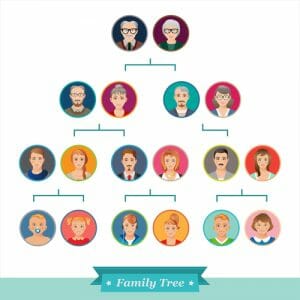 {Read in 7 minutes} For purposes of various proceedings in the Surrogate’s Court, it is sometimes necessary for the Court to make an official determination of who is (and who is not) among a deceased’s next-of-kin.
{Read in 7 minutes} For purposes of various proceedings in the Surrogate’s Court, it is sometimes necessary for the Court to make an official determination of who is (and who is not) among a deceased’s next-of-kin.
This may come up in a variety of ways. For example, when a person dies without a Will, the Court may need to determine who is most closely related to the deceased and should receive Letters to become the Administrator of their Estate. Sometimes the Court will need to know whether or not those appearing before the Court claiming to be the deceased’s children are actually the children of the deceased. Also when someone dies without a Will, the Court must determine which parties are biologically related to the deceased, and are thus entitled to inherit. This takes the form of a kinship hearing, as the Administrator is rendering his or her final account.
There are three usual ways in which an alleged relative may learn of a kinship proceeding for a relative:
– The relative may receive a notice from a Court called a Citation — perhaps a direct communication from the Administrator of the Estate — informing them of the upcoming proceeding.
– The relative may have seen an announcement printed in the paper where the Court ordered the printing of the Citation to be published in the community where the deceased’s family is presumed to reside. This is usually found in the classified ads along with other legal notices.
– The beneficiary may receive a communication from a genealogy company advising them that they are related to the deceased and entitled to an inheritance. They may offer to prove the relationship at a kinship proceeding … provided that the genealogy company receives one-third of any inheritance they recover.
If you or someone you know gets a communication like this, it’s often worthwhile to review it with an attorney. Paying an attorney by the hour to handle the matter can be significantly less expensive (thousands, tens of thousands, or hundreds of thousands of dollars less expensive, depending on the size of the Estate).
Regardless of how a relative gets the notice and whether they choose to work with counsel of their own choosing or the genealogy company, the Court will ultimately hold a kinship hearing at which the Court will take testimony to prove:
– That the relatives are actually related to the deceased; and
– That there are no more closely related relatives than those claiming an inheritance.
Let’s look at each of these separately.
First, how does one prove that they are related to the deceased?
Most Courts are hesitant to accept “spit test” genealogy results. They don’t want to see your online profile from Ancestry, 23andme, etc. An alleged relative needs to demonstrate kinship using more traditional means, such as vital records (government documents) and testimony. Usually, it is a combination of documentary evidence such as birth certificates, death certificates, census records, obituaries, cemetery records etc. and testimony from relatives of the deceased, friends of the deceased, and possibly a genealogist, who may be a key witness depending on A) the complexity of the family tree and B) the size of the Estate. (You should note that genealogists are available for hire regardless of whether you’re paying them by the hour or giving them one-third of the Estate.)
It’s important to recognize here that the Court will want certified copies of all of these documents. This will mean dealing with government entities to get certified official records or certified vital records, and having the newspapers, cemetery companies, or the United States Census Office certify their records so that they are admissible evidence in the hearing. These documents, combined with testimony from a friend, relative or genealogist, can often demonstrate kinship to the court in a satisfactory way.
Second, it’s important to prove that there are no more closely related relatives.
For example, let’s say that my aunt or uncle dies and I am their nephew. If they died without a will and if there are no more closely related relatives, I may be entitled to inherit by myself if I am the only nephew, or with the deceased’s other nieces or nephews (who would be my siblings or first cousins).
However, our inheritance rights rest solely on the fact that there is no person more closely related. Some things are easy to prove — for example, that the deceased’s parents are deceased is something we can demonstrate by showing death certificates. However, it is often difficult to prove that the deceased was not married at the time of his or her death, and even more complicated to prove that they did not have children at the time of death.
How might something like this happen? Let’s say the deceased, in their 20s, flew to a Caribbean island for a weekend, got married and then left without ever bothering to get an annulment or a divorce. Or let’s say that the deceased, while overseas for military service, business, or pleasure travel, fathered a child out of wedlock and never had a relationship with them.
This is what we call proving a negative, which is very difficult to do. Fortunately, our laws in New York provide that the court can presume that if nobody comes forward within three years after the date of the deceased’s death, that they do not exist.
At the conclusion of the kinship proceeding, the Court will render a decision determining who is entitled to inherit and at what amount, and at this point the relative can claim their inheritance.
If you wish to discuss this topic further, please contact me.

